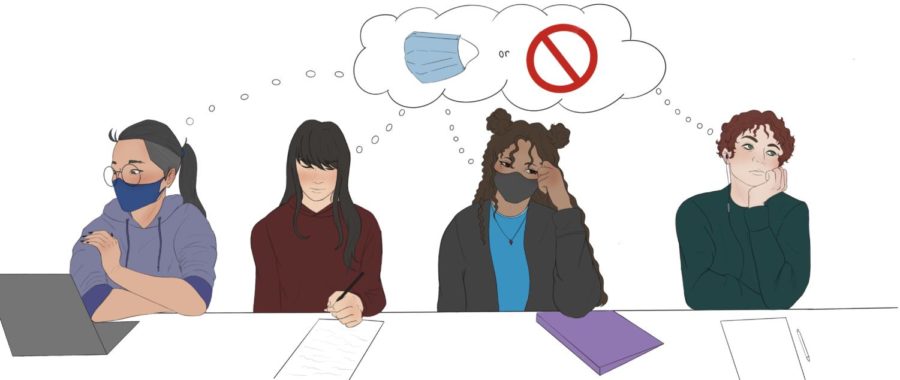In an attempt to stop the spread of COVID-19, protective face coverings have been required for the past two years by the Washington State Department of Health. This has recently changed, however, with Governor Jay Inslee lifting the mask mandate in Washington in mid-March, sparking many mixed feelings. With this new normal, the school district has been working towards establishing a community where all decisions and opinions are respected, even as many new questions arise.
A statewide indoor mask mandate was put into place by Gov. Inslee on June 26, 2020, directing all private businesses and institutions to require masks worn indoors at all times. This was implemented to slow the spread of COVID-19, as studies show that masks have an 80% efficiency against the transmission of influenza-like illnesses, with surgical masks such as the N95 blocking roughly 95% of particles in the air.
As the numbers of cases begin to decline, the state health department has been tasked with determining the point at which it is safe to no longer require masks. Edmonds School District Assistant Superintendent Greg Schwab gave context on some of the background information about the decision.
“Governor Inslee referred to [Washington State] scientific data, which seems to indicate that rates of COVID transmission and serious illness are on the decline, as we have seen the omicron variant work its way through our communities,” Schwab said. “Also, the Centers for Disease Control has issued similar recommendations that masking seems to no longer be something that needs to be mandated at the state or national levels.”
During mid-January, just as the omicron variant was moving through, there were an average of around 1,700 new daily cases per 100,000 people. In comparison, there are currently about 79 new cases daily per 100,000 people, meaning that the overall trend in new cases has gone down a significant amount. These numbers have greatly influenced Inslee’s decision on masking, leading to the announcement that the mask mandate was to be lifted on Saturday, March 12, 2022, no longer requiring masks indoors.
Schwab indicated that this statement would include all Washington state schools.
“This decision applies to all public and private schools in Washington, along with other public and private businesses and organizations,” he said.
The lifting of the mask mandate will no doubt have a profound effect across the state, not only because of the transition from masks, but also with the differences in opinion about mask-wearing becoming a more prominent issue. Many aren’t sure if lifting the mandate is a good idea, while others remain excited about it.
“I have casually spoken to a couple of my classes about it and there has been no shortage of people saying that they will continue to wear a mask to just watch the show at first and see if it’s really okay,” STEM teacher James Wilson said. “And I’ve heard students who feel really unsafe with the idea, and I’ve heard students who can’t wait to get the masks off.”
Along with emails from the school district, many students have found support from their teachers, many of whom have done check-ins, polls and discussions about the upcoming transition. These methods of reaching out to students have shown a range of opinions and thoughts about approaches to mask-wearing after the mandate is lifted.
Because of differences in perspectives towards mask-wearing, the district is looking ahead to address possible conflicts by proactively advocating consideration of others’ points of view.
“I think the main conflict coming up is that there are people on both sides of this issue who have differing opinions,” Schwab said. “We have heard already from both sides on this issue– some want us to stop requiring masks immediately and others want us to not follow the mandate and continue to require students and staff to wear masks in schools.”
Differing opinions on masking have been a problem since quarantine started in 2020, with varying reasons behind each point of view.
The wide range of opinions has the potential to create serious conflict, and both the school board and school are being very careful to promote inclusivity and respect for all decisions about mask-wearing.
In an email to the staff at Mountlake Terrace High School, principal Greg Schellenberg addressed these concerns.
“There is concern amongst groups of students and families that intend to voluntarily wear masks,” Schellenberg wrote. “We will establish and promote respect for all choices on masking.”
Another email sent to the entire Edmonds School District also specified how the issue of unkind controversy would be dealt with.
“The Edmonds School District will continue to recommend masking, however, it will be an individual or family decision and that decision will be respected,” Edmonds School District Superintendent Dr. Gustavo Balderas wrote. “We encourage families to discuss and decide if wearing a mask to school is right for your student. Bullying will not be tolerated for anyone wearing, or not wearing, a mask.”
Students are also facing some indecision when it comes to the lifting of the mask mandate.
“I feel like we’re approaching a point where it’s a personal choice,” sophomore Ben Marx said. “I think we should still strongly encourage it in densely-populated areas, especially indoors, but it’s not as important as the start of the pandemic or the omicron surge.”
Marx said he felt that mask-wearing should be an individual choice, but that the school could still strongly encourage or advise mask-wearing in crowded indoor places like hallways.
Sophomore Hannah Martins brought up a different point of view, expressing how, in some ways, it may be a little scary not wearing masks.
“The mask-wearing itself is uncomfortable, but the protection it gives has helped me with anxiety throughout the pandemic,” Martins said. “Honestly, when we aren’t required to wear masks, I’ll admit I’m scared.”
For many, masks served as a sense of comfort and protection through the stresses of COVID. However, Martins also pointed out some upsides of lifting the mask mandate, giving one example of the academic difficulty it brings.
“We can get to know our peers better when we can see each others’ faces,” Martins said. “I know in my ASL class learning has been really hard because sign language is an extremely expressive language, and the barrier of masks has been a large obstacle in the deaf community.”
Many classes are much harder to teach while using masks, whether it’s because of the lack of connection, or a physical barrier that’s needed when teaching a particular subject. The American Sign Language class, or, ASL, is an excellent example of a course that depends on a strong connection through facial expressions and the conveyance of feelings, both of which are made challenging by masks. Other classes may face the complication of pronunciation, musical tone for classes such as band or choir, or general lack of connection among students.
Chemistry and Astronomy teacher Mark Burbank reasoned with both sides of the argument.
“It [masking] certainly has scientific backing that it reduces everything [risks], as does social distancing and vaccinations,” Burbank said. “So as part of trying to reduce things, I really do support the masks, it really has helped, scientifically. But at the same time, I’m tired of it as well. Where is the balance going to be?”
Although most people continued to follow the mandate while it was in place, a lot were tired of wearing masks.
In addition to the academic downsides mentioned by Martins, the potential for more cases is very real. Without masks, the risk of infection increases greatly, and the school district, as well as the state, needs to be ready to react
“I think that we will have to be prepared to return to more masking if we see an increase in the number of COVID cases,” Schwab said. “As we know, COVID has proven to be tricky to deal with, so we need to understand that this may be a possibility. We hope not, but we should be ready.”
This potential risk of greater COVID-19 cases and exposure brings up the question of if this is a safe decision or not. Burbank indicated that he has a lot of confidence in the school district and its decision.
“From my working with the district and knowing the people involved in the decision, they did not take the decision lightly,” Burbank said. “They consulted national information, state information, the county board of health, the school board, and they’re trying to find the balance between health and welfare. The students, which is number one, but that also includes their mental health as well.”
In reaching its decision to lift mask mandates, the school district prioritized finding a balance between the mental health of students, teachers and staff, and physical safety from COVID-19 transmission.
With the lifting of the mask mandate, other mitigating strategies are being employed such as testing, and measures are being taken and improved daily to make COVID testing more accessible to all people.
“At the federal level they’re putting a lot of resources into things like prior testing, and having stockpiles of things,” Burbank said. “They’re also intimating a program now where you can go into a pharmacy and get tested, and if you get tested and it [rapid test] comes back positive, you can [immediately] get medications for things that will help you.”
As the COVID-19 pandemic progresses, the state and federal governments are working towards adapting to create a new normal that is closer to the pre-pandemic society.
Overall the consensus remains that although the mask mandate lifting may be new, respect towards others’ decisions still has to remain a priority.
“When we come to a time where it’s truly a choice, and that there are those who are choosing to wear masks and there are those who are choosing not to, and there’s no policy one way or another, I think that this is going to be time for our compassion and our understanding to come forward. It’s important that we respect the decision of people wearing masks,” Wilson said.



